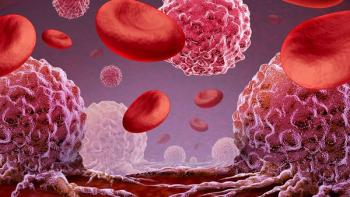
Novel Drug-Chemo Combo May Offer ‘New Standard of Care’ for Certain GI Cancers
Zolbetuximab plus mFOLFOX6 lengthened the time to progression for patients with CLDN18.2-positive, HER2-negative locally advanced unresectable or metastatic gastric/gastroesophageal junction (GEJ) adenocarcinoma.
Zolbetuximab plus mFOLFOX6 — a chemotherapy combination commonly used in gastric cancers — significantly improved time patients lived without their disease worsening compared to mFOLFOX6 alone in patients with CLDN18.2-positive, HER2-negative locally advanced unresectable or metastatic gastric/gastroesophageal junction (GEJ) adenocarcinoma, according to primary phase 3 data from the SPOTLIGHT trial.
Results presented during the
“Zolbetuximab plus mFOLFOX6 is a new potential standard-of-care treatment for a biomarker-based subgroup of patients with CLDN18.2-positive/HER2-negative locally advanced unresectable or metastatic gastric/GEJ adenocarcinoma,” said Dr. Kohei Shitara, the lead study author of the trial and a medical oncologist at National Cancer Center Hospital East in Japan, in a presentation during the meeting.
Standard treatment for patients with HER2-negative, metastatic gastric/GEJ adenocarcinoma is chemotherapy with mFOLFOX6, but there is still an unmet need in terms of targeted therapies for this population.Currently patients live for an average of about one year from treatment — a statistic known as overall survival.
Zolbetuximab ‘s target, CLDN18.2, is a protein that is expressed in normal gastric mucosa cells and is retained in advanced gastric/GEJ tumor cells. As CLDN18.2 may become exposed on the surface of gastric/GEJ cells, Shitara noted that it makes a promising target.
Zolbetuximab also resulted in a prolongation of survival in patients with higher expression of CLDN18.2 in the phase 2b FAST trial. Here, the average progression-free survival was nine months with zolbetuximab and epirubicin, oxaliplatin, and capecitabine (EOX), compared with 5.7 months with EOX alone; the average overall survival was 16.5 months and 8.9 months, respectively.
Additionally, the international, double-blind, placebo-controlled SPOTLIGHT trial enrolled patients with previously untreated locally advanced unresectable or metastatic gastric/GEJ adenocarcinoma and CLDN18.2 positivity. To be eligible for enrollment, patients must have had moderate-to-strong CLDN18 staining in at least 75% of tumor cells, have HER2-negative disease, and an ECOG performance status of 0 or 1, meaning that they have little, if any, complications performing their daily tasks.
Study participants were randomly assigned to receive the combination of zolbetuximab and mFOLFOX6 (283 patients) or placebo and mFOLFOX6 (282 patients).
Patients were divided by region (Asian vs non-Asian), number of organs with metastases (zero to two vs three or more), and prior gastrectomy (yes vs no).
The main goal of this study was progression-free survival. Key secondary endpoints were overall survival, time to confirmed deterioration in global health status/quality of life, physical functioning and OG25-Pain.
Additional outcome measures included objective response rate (percentage of patients whose disease shrinks from treatment), duration of response, safety and patient-reported outcomes.
As part of the study design, overall survival was only tested if the progression-free survival benefit with zolbetuximab was found to be significant. Shitara noted that the interim overall survival analysis was planned at the primary progression-free survival analysis, with a cutoff date of Sept. 9, 2022, for both analyses. In the interim overall survival analysis, a significant benefit was observed.
Forty-eight percent of patients in the zolbetuximab group received subsequent anticancer therapies, compared to 53% in the placebo arm.
Additional data showed that the 12- and 24-month progression-free survival
rates were 49% and 24%, respectively, in the zolbetuximab arm and 35% and 15%, respectively, in the placebo arm. The PFS benefit with zolbetuximab/mFOLFOX6 was observed across most prespecified subgroups, except for those whose primary site of disease was GEJ and with mixed/other classification.
The average overall survival was 18.23 months with zolbetuximab/mFOLFOX6 and 15.54 months with placebo/mFOLFOX6.
At 12, 24 and 36 months, the overall survival rates in the zolbetuximab and placebo arms, respectively, were 68% vs 60%; 39% vs 28%; and 21% vs 9%, respectively. Similar to the progression-free survival analysis, the overall survival benefit was seen in most patient subgroups, except for those with GEJ as the primary site of disease and others with mixed/other classification.
The objective response rate with zolbetuximab was 60.7% and 62.1%. The best overall response was a complete response in 5.7% and 3.3% of zolbetuximab- and placebo-treated patients, respectively; a partial response in 55.0% and 58.8% of patients, stable disease in 21.3% and 24.6% of patients, and progressive disease in 6.6% of patients on both arms. The median duration of response was 8.51 months on the zolbetuximab group and 8.11 months on the placebo group.
Shitara noted that the formal analysis is pending, but an initial descriptive analysis did not indicate differences between treatment arms.
Regarding safety, the incidence of side effects was similar between arms, at 99.6% in both treatment groups. Moderate or severe side effects were reported in 86.7% and 77.7% of those on the zolbetuximab and placebo groups, respectively; serious side effects occurred in 44.8% and 43.5%.
Treatment-related side effects that led to treatment discontinuation of zolbetuximab or placebo occurred in 13.6% and 2.2% of patients, respectively. Moreover, 1.8% and 1.4% of side effects, respectively, led to death.
The most common side effects associated with zolbetuximab/mFOLFOX6 were nausea (all-grade, 81.0%; grade ≥3, 16.1%), vomiting (all-grade, 64.5%; grade ≥3, 16.1%) and decreased appetite (all-grade, 47.0%; grade ≥3, 5.7%). Shitara added that the first occurrence of nausea and vomiting took place in the first or second treatment cycles. Of note, grade 3 or higher is considered severe or worse.
For more news on cancer updates, research and education, don’t forget to





